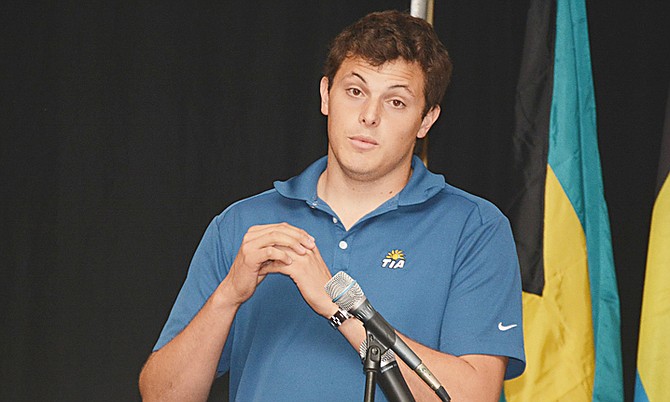Paul Aranha, of Trans-Island Air, pictured breifing audience members at The Caribbean Disaster Emergency Management Agency 9th Caribbean Conference on Comprehensive Disaster Management. Photos: Shawn Hanna/Tribune Staff
By RICARDO WELLS
Tribune Staff Reporter
rwells@tribunemedia.net
TWO months after Hurricane Joaquin roared through sections of the southern Bahamas, yesterday brought clarity to the tales of relief immediately following the storm.
During a panel discussion at the Caribbean Disaster Emergency Management Agency’s (CDEMA) ninth annual Caribbean Conference on Comprehensive Disaster Management, personnel critical to the response efforts in the wake of the category four storm shared their accounts of the aftermath of Joaquin.
Joaquin battered the central and southern Bahamas on October 1 and 2, destroying homes and buildings and leaving severe flooding in its wake.
One of the four panellists, Scott Lewis, of the Pathfinders Task Force whose initial reports help form critical response efforts, said he couldn’t forget the moment his phone rang shortly after Joaquin began to flood portions of Long Island.
On the other end of the line was NEMA Director Captain Stephen Russell, who was again requesting the help of an agency he had turned to so many times before following disasters in the Bahamas.
“I heard (Captain Russell), he said he needed me and the Pathfinders to make our way to the islands to do what we did best,” he said pointing at Capt Russell seated in the front row during the discussion. “Six hours later we were here in the hub centre, we were working to get an understanding of what was going on.”
That was Thursday, October 1.
Meanwhile, Paul Aranha of Trans-Island Airways, whose company was one of the earliest responders after the storm, used his opportunity yesterday to praise the work and effort of the Royal Bahamas Defence Force (RBDF) and the Department of Civil Aviation.
On Friday, October 2, Mr Aranha sat in on a two-hour Long Islanders Association meeting, seated among terrified family members and concerned stakeholders, and devised a plan to fly what would become the first fact-finding flight into the area.
According to Mr Aranha, without the immediate operation spearheaded by the RBDF and Civil Aviation his critical response flight – which headed out hours after the all-clear sign was given for those southern islands battered by the storm – would not have been possible.
“After the hurricane hit, everyone was running around saying that the government wasn’t doing anything; that was a common theme throughout the hurricane relief. But I can tell you from working in the hurricane relief that the government did a whole lot. It was the government departments that didn’t make a lot of noise that were doing everything that they could,” Mr Aranha said, referring to the two units.
He recalled his initial flight into Long Island on Saturday, October 3, saying that efforts by Civil Aviation that morning ensured that he could take off. “We had probably 100 civilian airplanes that hadn’t flown with each other before and we, just in our group, flew some 430 flight hours in the first 30 days. Everyone of those flights took off without incident or without accident.”
Due to the rough seas immediately following the storm, critical response efforts had to come by air support. The features of the RBDF are limited to naval responses, therefore aerial efforts were the only way into islands left devastated by Joaquin.
Rob Ceravolo, owner and operator of Florida-based Tropic Ocean Airways, delivered a passionate plea to residents of South Florida to help aid effort in the Bahamas. Mr Ceravolo told a Florida news station that due to a lack of an organised effort by the Bahamian government, he sprung into action to aid and assist as many people as he could. A day earlier he is said to have delivered five separate seaplane loads of supplies to islands in the southern Bahamas.
Yesterday, Mr Ceravolo said the best way to describe the efforts he saw over the course of that weekend was “spectacular”.
“Over the course of five-days we moved 50,000 pounds of cargo. By day two (October 4) we were able to co-ordinate with Paul’s group out of Nassau, with Pathfinders, with NEMA and actually get an idea of what was truly going on.”
Working together to form a comprehensive plan with units on each affected island, NEMA and a number of other groups, the unexpected relief team was able to communicate directly with CDEMA.
General Earl Arthurs, CDEMA operations specialist stationed in the Bahamas, after the storm credited the initial work done by the group as the “roadmap” to what proved to be one of the best private response efforts he has ever seen.
Hurricane Joaquin has left in its wake $57m worth of damage to government buildings and infrastructure. Prime Minister Perry Christie has estimated 836 homes were completely wiped out by the storm. He has also noted that the storm destroyed 413 homes in Long Island, 227 houses in San Salvador, 123 homes in Acklins, 50 houses in Crooked Island and 23 in Rum Cay.
The panellists yesterday among many other things called for the establishment of emergency operation centres on each inhabited island, insisting that such a facility would help organise efforts in the aftermath of a major disaster.
CDEMA is a regional inter-governmental agency for disaster management in the region established in 1991.





Comments
Use the comment form below to begin a discussion about this content.
Sign in to comment
Or login with:
OpenID